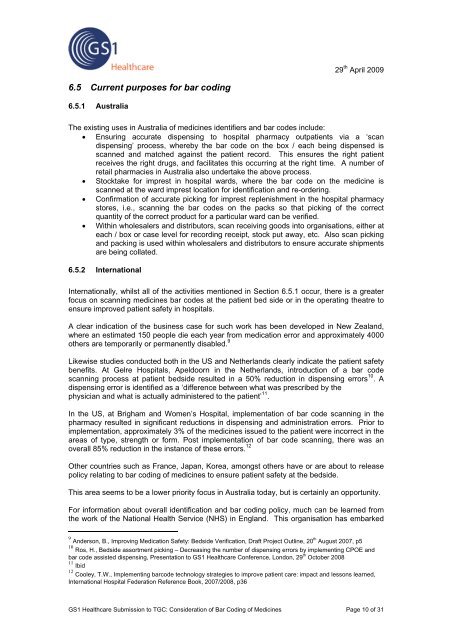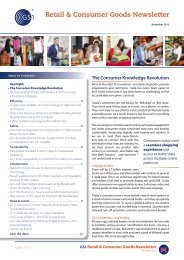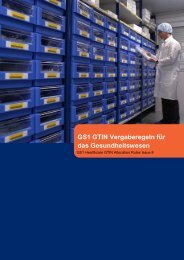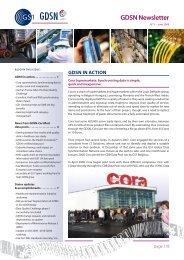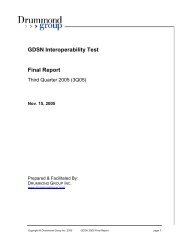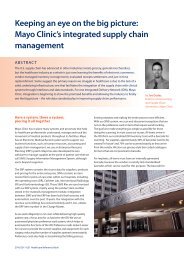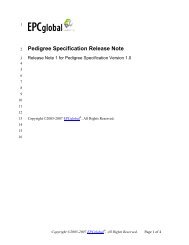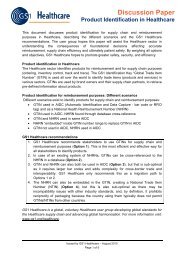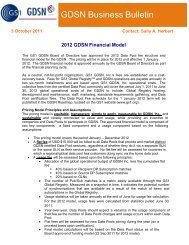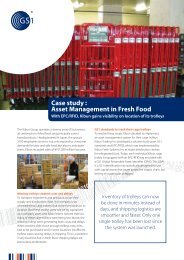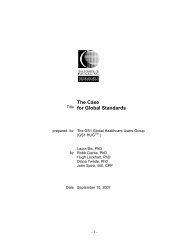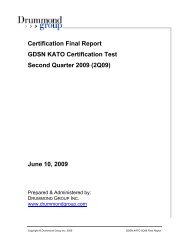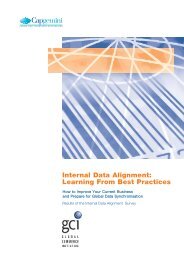Combined GS1 Healthcare and GS1 Healthcare User Group ...
Combined GS1 Healthcare and GS1 Healthcare User Group ...
Combined GS1 Healthcare and GS1 Healthcare User Group ...
Create successful ePaper yourself
Turn your PDF publications into a flip-book with our unique Google optimized e-Paper software.
29 th April 2009<br />
6.5 Current purposes for bar coding<br />
6.5.1 Australia<br />
The existing uses in Australia of medicines identifiers <strong>and</strong> bar codes include:<br />
• Ensuring accurate dispensing to hospital pharmacy outpatients via a ‘scan<br />
dispensing’ process, whereby the bar code on the box / each being dispensed is<br />
scanned <strong>and</strong> matched against the patient record. This ensures the right patient<br />
receives the right drugs, <strong>and</strong> facilitates this occurring at the right time. A number of<br />
retail pharmacies in Australia also undertake the above process.<br />
• Stocktake for imprest in hospital wards, where the bar code on the medicine is<br />
scanned at the ward imprest location for identification <strong>and</strong> re-ordering.<br />
• Confirmation of accurate picking for imprest replenishment in the hospital pharmacy<br />
stores, i.e., scanning the bar codes on the packs so that picking of the correct<br />
quantity of the correct product for a particular ward can be verified.<br />
• Within wholesalers <strong>and</strong> distributors, scan receiving goods into organisations, either at<br />
each / box or case level for recording receipt, stock put away, etc. Also scan picking<br />
<strong>and</strong> packing is used within wholesalers <strong>and</strong> distributors to ensure accurate shipments<br />
are being collated.<br />
6.5.2 International<br />
Internationally, whilst all of the activities mentioned in Section 6.5.1 occur, there is a greater<br />
focus on scanning medicines bar codes at the patient bed side or in the operating theatre to<br />
ensure improved patient safety in hospitals.<br />
A clear indication of the business case for such work has been developed in New Zeal<strong>and</strong>,<br />
where an estimated 150 people die each year from medication error <strong>and</strong> approximately 4000<br />
others are temporarily or permanently disabled. 9<br />
Likewise studies conducted both in the US <strong>and</strong> Netherl<strong>and</strong>s clearly indicate the patient safety<br />
benefits. At Gelre Hospitals, Apeldoorn in the Netherl<strong>and</strong>s, introduction of a bar code<br />
scanning process at patient bedside resulted in a 50% reduction in dispensing errors 10 . A<br />
dispensing error is identified as a ‘difference between what was prescribed by the<br />
physician <strong>and</strong> what is actually administered to the patient’ 11 .<br />
In the US, at Brigham <strong>and</strong> Women’s Hospital, implementation of bar code scanning in the<br />
pharmacy resulted in significant reductions in dispensing <strong>and</strong> administration errors. Prior to<br />
implementation, approximately 3% of the medicines issued to the patient were incorrect in the<br />
areas of type, strength or form. Post implementation of bar code scanning, there was an<br />
overall 85% reduction in the instance of these errors. 12<br />
Other countries such as France, Japan, Korea, amongst others have or are about to release<br />
policy relating to bar coding of medicines to ensure patient safety at the bedside.<br />
This area seems to be a lower priority focus in Australia today, but is certainly an opportunity.<br />
For information about overall identification <strong>and</strong> bar coding policy, much can be learned from<br />
the work of the National Health Service (NHS) in Engl<strong>and</strong>. This organisation has embarked<br />
9 Anderson, B., Improving Medication Safety: Bedside Verification, Draft Project Outline, 20 th August 2007, p5<br />
10 Ros, H., Bedside assortment picking – Decreasing the number of dispensing errors by implementing CPOE <strong>and</strong><br />
bar code assisted dispensing, Presentation to <strong>GS1</strong> <strong>Healthcare</strong> Conference, London, 29 th October 2008<br />
11 Ibid<br />
12 Cooley, T.W., Implementing barcode technology strategies to improve patient care: impact <strong>and</strong> lessons learned,<br />
International Hospital Federation Reference Book, 2007/2008, p36<br />
<strong>GS1</strong> <strong>Healthcare</strong> Submission to TGC: Consideration of Bar Coding of Medicines Page 10 of 31


